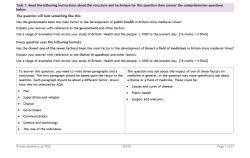How to answer the 16-mark question (the 'factors' essay question) on AQA's 'Britain: Health and the people' exam

An information-packed GCSE history revision booklet for the AQA thematic study option on the development of medicine through time – Britain: Health and the people: c.1000 to the present day.
This 33-page booklet begins by outlining the structure of the ‘factors’ essay question and what is required, with comprehension questions to check students’ understanding. It reminds students of the following factors, themes and periods that may be tested in the exam:
Factors
- War
- Superstition and religion
- Chance
- Government
- Communication
- Science and technology
- The role of the individual
Themes
- Causes and cures of disease
- Public health
- Surgery and anatomy
Periods
- Medieval period / the Middle Ages
- Early modern period
- Industrial Revolution
- Modern medicine
It includes an essay plan table for each factor, with information to give students ideas for their essay plan. This information is followed by model paragraphs for each factor and theme, showing students how to tailor the information to fit a particular theme and link it together to form a coherent paragraph.
The information provides detailed coverage of the development of medical treatment in Britain, including vaccination, X-rays, germ theory, penicillin, anaesthetics and the creation of the NHS, and of key individuals such as Florence Nightingale, Edward Jenner, William Harvey, Florey and Chain, and Alexander Fleming.
You might also like Health and the people: exam-style practice question.
An extract from the information about superstition and religion:
During the Renaissance, people like Vesalius began to question the work of Galen, and the Church reacted by trying to stop this. Vesalius was forced to leave his job at Padua. It took powerful patrons to protect these people from the wrath of the Church.
An extract from the information about the role of individuals:
Vesalius used his own experiments to challenge the work of Galen, and his lectures, during which he carried out dissections himself, were extremely popular. He published an illustrated textbook, On the Fabric of the Human Body, in 1543.
